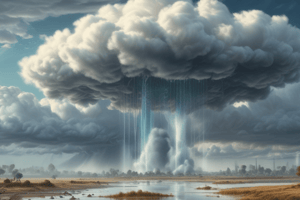Podcast
Questions and Answers
The process of changing the vapor form of water into a liquid form is called ______.
The process of changing the vapor form of water into a liquid form is called ______.
condensation
A ______ is formed when a cold air mass and a warm air mass meet, causing the warmer air to rise over the colder air.
A ______ is formed when a cold air mass and a warm air mass meet, causing the warmer air to rise over the colder air.
front
Which of the following weather phenomena is characterized by high pressure in the center and clockwise circulation in the northern hemisphere?
Which of the following weather phenomena is characterized by high pressure in the center and clockwise circulation in the northern hemisphere?
- Cyclone
- Anticyclone (correct)
Match the following weather phenomena with their typical locations:
Match the following weather phenomena with their typical locations:
Which of these forms of precipitation has a drop diameter of 0.2 to 0.5 mm?
Which of these forms of precipitation has a drop diameter of 0.2 to 0.5 mm?
Snow is formed by sublimation, a process where ice crystals directly form from water vapor.
Snow is formed by sublimation, a process where ice crystals directly form from water vapor.
Dew forms on cool surfaces in the morning due to ______ of water vapor.
Dew forms on cool surfaces in the morning due to ______ of water vapor.
Which of these forms of precipitation is a thin deposit of ice that forms when the air temperature is below freezing but above freezing point?
Which of these forms of precipitation is a thin deposit of ice that forms when the air temperature is below freezing but above freezing point?
What form of precipitation is characterized by small water droplets suspended in air near the ground, reducing horizontal visibility, often forming when the air is near the dew point temperature with calm winds and a high relative humidity?
What form of precipitation is characterized by small water droplets suspended in air near the ground, reducing horizontal visibility, often forming when the air is near the dew point temperature with calm winds and a high relative humidity?
What type of precipitation is a mixture of fog and smoke, commonly found in urban and industrial areas?
What type of precipitation is a mixture of fog and smoke, commonly found in urban and industrial areas?
Mist is a very thin fog, consisting of tiny hygroscopic particles suspended in the air.
Mist is a very thin fog, consisting of tiny hygroscopic particles suspended in the air.
Flashcards
Warm cloud seeding
Warm cloud seeding
A method to increase rainfall by introducing hygroscopic particles into warm clouds.
Hygroscopic molecules
Hygroscopic molecules
Substances that attract water molecules, like salt.
Coalescence
Coalescence
The process where water droplets collide and merge to form larger drops.
Condensation
Condensation
Signup and view all the flashcards
Front
Front
Signup and view all the flashcards
Anticyclone
Anticyclone
Signup and view all the flashcards
Cyclone
Cyclone
Signup and view all the flashcards
Rain
Rain
Signup and view all the flashcards
Drizzle
Drizzle
Signup and view all the flashcards
Snow
Snow
Signup and view all the flashcards
Dew
Dew
Signup and view all the flashcards
Frost
Frost
Signup and view all the flashcards
Fog
Fog
Signup and view all the flashcards
Smog
Smog
Signup and view all the flashcards
Mist
Mist
Signup and view all the flashcards
Willy willy
Willy willy
Signup and view all the flashcards
Hurricane
Hurricane
Signup and view all the flashcards
Typhoon
Typhoon
Signup and view all the flashcards
Baguio
Baguio
Signup and view all the flashcards
Study Notes
Warm Cloud Seeding
- Requires hygroscopic molecules (water attracting) like salt, urea, or ammonium nitrate
- Coalescence process creates rain drops in warm clouds
- ABC (Indian Ocean Brown Cloud) is a pollution blanket impacting agriculture and monsoon patterns
Precipitation
- Condensation: Water vapor changes to liquid
- Front: Boundary between air masses (cold and warm)
- Anticyclone: High-pressure area with clockwise rotation (Northern Hemisphere)
- Cyclone: Low-pressure area with counter-clockwise rotation (Northern Hemisphere)
Forms of Precipitation
- Rain: 0.5-7 mm drop diameter
- Drizzle: 0.2-0.5 mm drop diameter
- Snow: Ice crystals from sublimation
- Dew: Moisture condensing on cool surfaces (beneficial to crops)
- Frost: Ice deposit from water vapor sublimation (below freezing)
- Fog: Tiny water droplets reducing visibility (ground-level cooling)
- Smog: Mix of fog and smoke (cities/industrial areas)
- Mist: Very thin fog with suspended hygroscopic particles
Studying That Suits You
Use AI to generate personalized quizzes and flashcards to suit your learning preferences.




